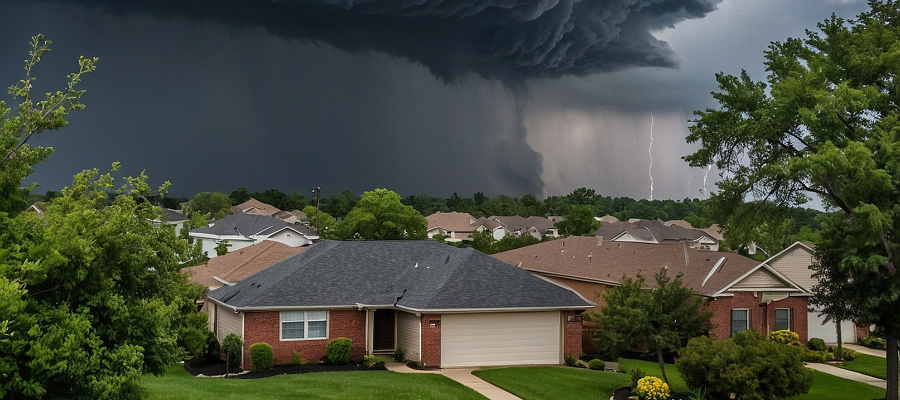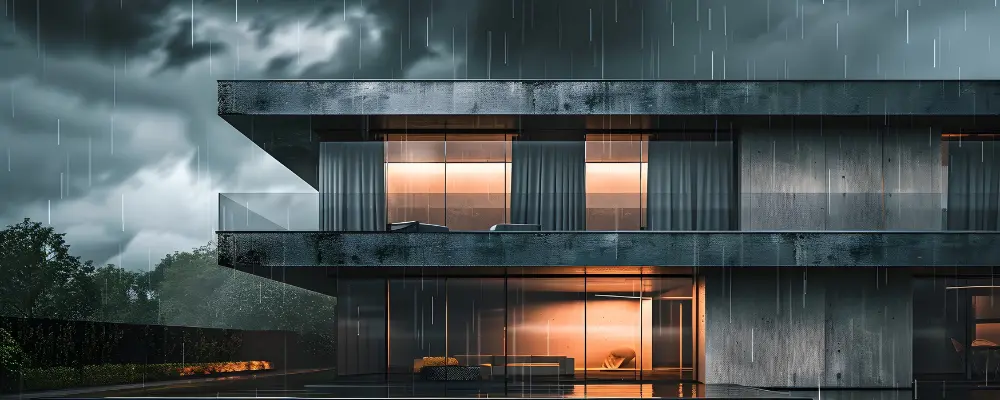After the scorching heat of summer, monsoon brings relief to our souls. With the sound of the raindrops, the smell of rain and the cool breeze, the season brings joy to everyone. Most of us love to keep the windows open, allowing the refreshing wind carrying the earthy fragrance to rush into your spaces, rejuvenating our minds and souls.
Since the Indian subcontinent receives ample rainfall during the season, we must adjust to sudden and constant dampness. Most homeowners experience problems during and after the monsoon. You might notice a collection of moisture in the walls, resulting in damp patches, cracked walls, and peeling paint. Since these cause severe problems, in this blog, Brick & Bolt offers some tips to protect your home walls during the monsoon.
- 1 Understanding the Impact of Monsoon on Your Home Walls
- 2 Tips to Protect Your Home During the Monsoon
- 2.1 Waterproof the Exterior Walls and Roof
- 2.2 Remove Stagnant Water and Repair the Pipes
- 2.3 Unclog the Drainage
- 2.4 Apply Waterproof Paints
- 2.5 Check for any Leakages
- 2.6 Ensure Your Doors and Windows are Watertight
- 2.7 Inspect Exposed Wires
- 2.8 Protect Your Clothing, Carpets and other Upholstery Items
- 2.9 Cover Your Open Spaces
- 3 Conclusion
Understanding the Impact of Monsoon on Your Home Walls
Characterized by high humidity and heavy rains, the monsoon season has an impact on the structural integrity and aesthetic appeal of your home walls. These include the following:
Structural Damage
Water infiltration during heavy rains in the monsoon season is responsible for severe structural damage. Your walls receive the maximum rain. Prolonged exposure to moisture weakens the foundation of your walls, leading to cracks. In extreme cases, it might lead to structural instability. The wet and dry cycles cause constant expansion and contraction, deteriorating the materials and adversely affecting your walls’ strength and stability.
Moisture and Dampness
Increased moisture and dampness are the primary effects of the monsoon. During the monsoon, certain areas receive persistent rainfall. If your walls have cracks, gaps, or are made of porous materials, rainwater will pass through them. You can experience dampness later as wet patches on your walls, peeling paint, and bubbling plaster. Over time, the moisture weakens the walls, making them susceptible to damage and decay.
Growth of Mold and Mildew
Have you ever noticed green spots on old walls? These are mold and mildew. During the monsoon, your walls remain damp continuously, which creates a perfect environment for the growth of mold and mildew. The moist and humid environment of the monsoon is ideal for their survival. Beyond the aesthetic damage, these fungi pose health risks. If you or anyone in your family is suffering from respiratory disease or allergies, exposure to mold and mildew can be fatal. The spores released by these fungi cause indoor air pollution, exacerbating health problems.
Paint and Plaster Deterioration
The temperature fluctuates during the monsoons. The combination of moisture and fluctuating temperatures deteriorates the paint and plaster. You might notice that the paint starts peeling, bubbling, and fading. Plaster, on the other hand, starts cracking and falling off in chunks. Besides affecting the aesthetic of your home, it exposes the underlying materials to further damage.
Efflorescence
Efflorescence stands as another common cause during the monsoon season. It occurs when moisture brings the water-soluble salts to the surface. When the rain stops, the water from your home walls evaporates, leaving behind white, powdery deposits on your walls. Although efflorescence is not harmful, it indicates that prolonged exposure of your walls to moisture might lead to significant problems if you fail to address them.

Tips to Protect Your Home During the Monsoon
Monsoon is a favourite season for most of us, filling our souls with the smell of rain and the first drops of air land announcing its arrival. However, the heavy rains dampen your walls, acting as a breeding ground for mildew, mold and even insects. Does it sound like a nightmare? Whether you live in a house, villa, bungalow, mansion or apartment, you can easily follow these wall maintenance tips for the rainy season.
Waterproof the Exterior Walls and Roof
Thoroughly check for the presence of cracks in your home’s walls and roof. Water seeps through these spots. If your walls even have a minute crack, you must repair them immediately and apply a waterproof coating to seal the cracks. Are you unsure about the presence of cracks? Check the paint on your walls. Is the paint on your walls peeling? Do not ignore it, as they indicate water seepage and dampness.
If you are looking for a permanent solution, you can opt for the best quality tiles for your home. Wall tiles, roof tiles and elevation tiles are ideal for your home. Besides protecting you walls from water-related damage, these tiles provide you with a look that you will love and cherish. Choose low porosity tiles such as vitrified, ceramic and porcelain tiles. They absorb minimal water, thereby preventing water seepage and water damage.
Remove Stagnant Water and Repair the Pipes
Check your house and its surrounding area for the presence of stagnation, as it is an excellent breeding ground for mosquitoes. Besides, prolonged stagnant water weakens your building’s structure. Check your drainage system and remove all kinds of debris. It will prevent water from backing up and accumulating. Check your home’s internal and external pipes thoroughly for the presence of any cracks or breakdowns. Doing so helps reduce leakage, water seepage and dampness.
Unclog the Drainage
No one likes clogged drainage. Therefore, it is essential to inspect your drainage regularly. Doing so helps you to identify any underlying issue with the drainage. Early intervention prevents further damage and expenses. You can fix the issue instantly, avoiding further problems.
Apply Waterproof Paints
The type of paint you select determines the durability of your home’s building. Avoid applying high-gloss paints. Apply exterior paints in the summer for a longer lifespan, as the temperature remains ideal for proper drying of the paint. Never paint your exterior walls during the winter, as the humidity will cause the paint to flake.
Check for any Leakages
Do you live in your ancestral home? If yes, then you might notice fissures along the home’s ceiling, walls and pipes. Although common in old homes, you might find these in new ones as well. What is the best solution? Check for the fissures and examine any leaky taps. These places never stop dripping. Irrespective of the seasons, you always need to check and repair them. The damp swelling on your painted walls gives a bloated effect. If you are experiencing the same, check your external pipes and address the issue.
Ensure Your Doors and Windows are Watertight
Add rubber gaskets to your entrance doors and those leading to your balcony. These are excellent ways to stop rainwater from entering indoors. If you are living in an area where flooding is common, it is the best method. If your doors and windows have gaps, rainwater can seep in, causing damage to your walls and floors. Use foam and silicon sealants to fill these gaps. If you are looking for an inexpensive method to fill your doors and windows gap, try using weather strips.
Inspect Exposed Wires
Connect with an electrician to check your home’s wiring and ensure that there are no exposed wires. Ensure that no wires, doorbells, or switchboards come in direct contact with water. This will prevent you from experiencing an electric shock. During monsoons, ensure that you unplug all electronics and appliances to prevent them from getting shorted.
Protect Your Clothing, Carpets and other Upholstery Items
Carpets are a breeding ground for mildew, mold, and other germs that develop during the wet season. If you use removable carpets and rugs, roll them up and store them in a cool and dry place during the monsoons. Never place wet items on the sofa and armchairs. This prevents your upholstery from getting damp and rusty.
While storing your clothes and other linens, place sufficient moisture absorbers, such as silica gel packets, in the cupboards and wardrobes. This prevents dampness from seeping through the cupboards, and your belongings will never develop a musty smell.
Cover Your Open Spaces
Do you live in an area experiencing heavy rainfall? If yes, there is a high probability that water will enter your home through your balcony. To prevent flooding, you can install permanent or temporary awnings over your veranda. Besides preventing rainwater from entering your spaces, your awnings prevent your outdoor furniture from damage.
Conclusion
Although monsoon is a fun and delightful season, it gets better when you make your home monsoon ready. Get your home inspected for leaks, cracks, drainage problems and other issues in advance to prevent flooding and damage. By implementing the above-mentioned tips, you can prevent your home and other belongings from moisture, mold and mildew, keeping your home beautiful for years to come.
Brick & Bolt, a prominent construction company in India, understands the overwhelming effort involved in building their customers’ dream homes. As a tech-enabled firm, they ensure that the process of building your dream home is smooth, efficient, and memorable. Clients can communicate with the project manager regarding the booking process, designs, procedures, and quotations. With Brick & Bolt, you get everything at your fingertips.

